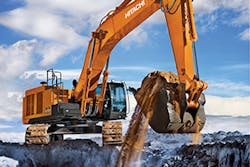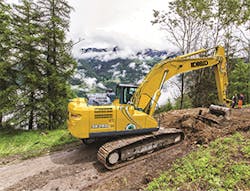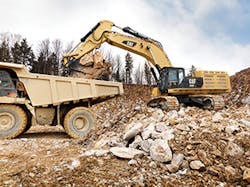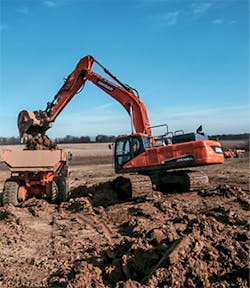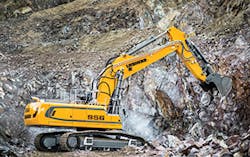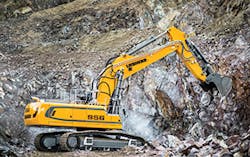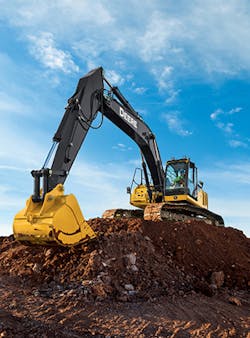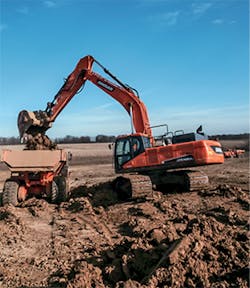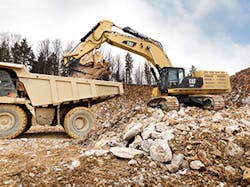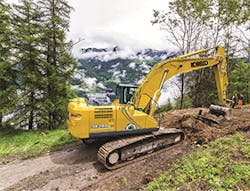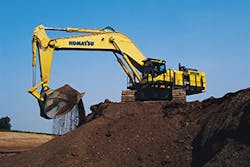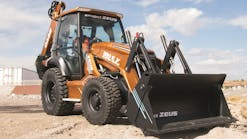Large excavators are used when there is a large volume of material that has to be dug out and loaded into trucks, states Dave Donneral, specialized machinery sales manager for Kobelco. They can also lift or move large items in situations where a crane would not be usable and can carry and use large tools (such as shears, hammers, and grapples) that are required for demolition of power plants, industrial structures, commercial or residential buildings, and other structures.
One of the largest factory-built machines is Kobelco’s SK1000D, weighing 220,000 pounds. It can reach 62 feet in the air and use a 21,600-pound shear. It can also be easily adapted to reach 124 feet in the air with a 5,700-pound shear.
The largest excavators make the most sense on job sites that require a lot of material to be moved in an efficient manner. “This size of machine makes the most sense when moving a large amount of material as fast as possible with the least amount of cycle times,” says Marcus Barnes, product specialist/inside sales coordinator for Liebherr USA, Co., Construction Equipment Division. “For these size machines, it is all about the production of the machine. In Liebherr’s Construction Equipment Division, our production class of excavators starts with the R 956 (55-ton) to a R 976 (93-ton).”
Digging with a Liebherr R 956
Most of the big crawler excavators working in North America are on large roadway excavation job sites, loading an articulated dump truck or a side dump truck, says Aaron Kleingartner, marketing manager, Doosan Construction Equipment. “For example, if an interstate section is being completely redone, including removing concrete and the subsurface material, a big crawler excavator—between 42 and 53 metric tons—is commonly used to remove the material.”
A 47-metric-ton excavator from John Deere is typically used for road construction and on large job sites where mass land excavation is performed for housing developments. The company also offers a 67-metric-ton and an 87-metric-ton for rock quarries and moving aggregate, but David Young, the product marketing manager for excavators in the Americas, explains that those are not typically mobile units.
The 470 can move “a lot of dirt in a short period of time,” continues Young. “It’s large enough to do earth moving and versatile enough to use attachments, including a demo claw, flat blade plate compactor (for putting in pipe, removing overburden, placing pipe, and compacting), and a hammer so you don’t need two machines. You don’t want to unhook in residential developments. You don’t want extra equipment there.”
The big machines are good at material handling, concurs Justin Lantin, product marketing manager, large excavators, Komatsu. “They’re great for mass excavation where you need to move a lot of material—such as in quarries and mines.” They can dig deep sewer trenches and do deep foundation work, thanks to their reach, and are also good for demolition.
Customers typically look at how many cubic yards of material they need to move and their productivity targets to justify these large-sized excavators. A good rule of thumb for a PC1250LC-8 size excavator is a job requiring a million cubic yards of material to be moved.
A John Deere 300GLC reaches for another scoop.
Large excavators are available in mass excavation configurations with shorter booms and arms, which provide increased digging forces and accept larger buckets. “[Their] only job is moving large amounts of material efficiently,” says Lantin.
In fact, over the last 20 years, hydraulic excavators have become the “go-to” construction machine for fast, efficient material moving, says Michael Watt, excavator product manager for LiuGong North America. Their largest, the 970E, is currently not imported into the North America market due to North American emissions ratings.
Mining
Another common application for the biggest crawler excavators is removing overburden in mining environments. Overburden is the material that should be removed before getting to what needs to be mined: removing topsoil and subsoil to get to iron ore or coal.
Conventional excavators are available from most manufacturers up to the 85-ton class range. After that, says Donneral, they switch to what is considered a mining class machine, which is typically 120 tons or more. Due to their size and the cost of transport, they are usually brought to a site for assembly and spend most of their life at that site.
Specialized machines like this work in one place all their life, Lantin confirms, but they work in more places than just mines. Some unload barges or handle scrap, two applications where their long reach and stability are advantageous.
There’s increasing demand for specialty builds of these larger excavators as demolition machines, Donneral indicates, because their larger size allows them to lift larger shears and tools to higher elevations than a standard machine would. “These ‘super machines’ are custom-built and very expensive to own, operate, and move, but sometimes due to the size of the material they have to process and cut, the cost is justified.”
They’re often used for large building demolition, sporting stadiums, power plants, and industrial demolition. To meet this demand, Kobelco offers a fleet of factory-built specialty demolition machines in markets outside the US up to the SK3500D, which is 732,000 pounds.
Liebherr’s 800-ton excavator is suitable for mining, but Barnes says the R 976, at 93 tons, is Liebherr’s largest construction excavator for quarries, general excavations, and utility contractors. “The biggest job our R 976 excavator could handle is either loading out trucks or feeding a crusher in a rock quarry.”
Heavy lifting with a Doosan DX420LC
In quarries, these machines are specially built with heavy-duty undercarriage components that can withstand the rocky and uneven terrain. In extreme quarry applications, Liebherr makes an SME model (Super Mass Excavation) that features the next size heavy-duty undercarriage, heavier counterweight, and bigger cylinders for increased breakout and digging forces.
These excavators must be able to perform many different tasks to get the maximum utilization to justify their costs, but there are jobs where a large machine can be warranted for its lifting capacity and large-capacity buckets. “These machines have large buckets and are specifically made to dig material and load trucks in the most cost-effective way,” continues Donneral.
“It’s important for excavator owners and their operators to use a properly sized bucket to efficiently load a rigid truck or ADT,” adds Kleingartner. Doosan excavators in this size class generally have a 4-cubic-yard bucket attached to the excavator’s arm. A Doosan DX530LC-5 excavator with a 4-cubic-yard bucket can load a truck in three or four passes, maximizing efficiency. Doosan DX530LC-5 excavators typically have a standard boom and arm configuration because a shorter boom gives the machine more breakout force and optimizes the machine for digging in heavy, harsh materials, such as those found in certain parts of Canada, Texas, and the southwest US.
Making Sense for Moving Things
Every job site requires an excavator of some size. According to Young, 35–40% of all construction industry volume and all machines sold are excavators.
How do you decide if you need a large excavator? Simply put, when you need to move massive amounts of material—effectively and efficiently—all day every day, big excavators are the right choice. Young offers a set of questions to help contractors determine what they need:
- Do you want it for one job or more?
- How long will you be on the job site?
- How quickly do you need to get the job done?
- Do you need a mobile machine or will it live in a quarry?
Rockin’ out with a Cat 390F Hex
LiuGong’s Watt also asks a few basic questions to help determine the needed size but says that job site conditions must be considered. The larger the excavator, the fewer passes are required to get the job done—and the less damage to the ground.
Other considerations are how far below ground the bucket needs to go. “Each excavator has a standard digging depth, depending on its metric weight, so you must ask how far is the machine required to dig below ground,” explains Watt. The required size of the bucket is another aspect to take into account. “If you are going to dig a 0.35-meter trench (14-inch) and are only going to get paid to remove that amount of material, then you must size the excavator and bucket accordingly.”
But perhaps the major consideration is space when there is no room for a wheel loader to make a 3-point turn, Watt claims. “Excavators can do the same job with no movement of the tracks, as the excavator is a two-piece machine. [Its] lower frame places the bucket close to material being moved. The top frame can place the bucket anywhere in a 360-degree cycle from where the material was removed to where the truck is located.”
Caterpillar’s 390 makes sense when you need to lift and set extremely heavy objects like large concrete structures, says Ryan Neal, product application specialist. They’re also commonly used in sand and gravel operations, as well as quarries, where they strip overburden and load trucks. “[They] also do very well on large earthwork projects, like developing commercial sites, building airports and dams, and even digging out massive lakes for residential housing.”
One Caterpillar customer had a project to dig a large lake with a 390. Neal reports that the machine moved an average of 1,900 tons of material per hour with a 6-cubic-yard bucket. Considering that their 20-ton excavators can move nearly 490 tons per hour, the advantage of the larger machine is clear.
Productivity
The advantage of using a crawler excavator in this size class is the productivity the machine offers, thanks in part to large-capacity buckets and strong breakout forces when digging in tough, difficult materials. Simply put, you can move more material quickly—particularly with the smooth hydraulics offered by Deere, says Young. “They make it easy to operate for long periods.” It’s particularly beneficial for less experienced operators who tend to be less fluid and can suffer from fatigue when working long hours.
Because it’s difficult to find experienced operators these days, says Sebastian Witkowski, product marketing manager, intelligent machine control, Komatsu, their full line of intelligent excavators with fully integrated GNS technology is beneficial in getting close to grade faster. With accuracy displayed in real time, he says there’s “no worry about going past grade,” explaining the importance of always knowing where you’re at. “You can get good results with inexperienced operators.”
On the road with a Kobelco SX260LC
It reduces construction time 50% vs. traditional methods, he continues, allowing operators to finish jobs faster and contractors to get more work. “Operators can run quicker cycle times with full buckets. They are not moving dirt twice; they’re able to use the machine better without needing dozers to clean up.” Less manpower, time, equipment, and fuel add up to a “big ROI.”
Caterpillar’s two-dimensional grade system guides operators to the correct depth, slope, and horizontal distance in real time. Costs are minimized because operators reach target grade more quickly and consistently, with fewer ground personnel needed to check grade.
Several companies are offering GPS systems that will work in unison with the machine to provide accurate real-time data to map. This system can also assist the operator by controlling some of the functions of the machine to ensure the grade matches the pre-programmed data. According to Donneral, Kobelco is working with Trimble on plans to introduce Grade Control, “where all the operator has to do is raise the boom and the GPS system will control the arm and bucket function to ensure the proper grade is achieved.”
Similarly, LiuGong is working with its partners on grade control that will assist the operator to place the bucket in a workspace that is digitally mapped. It will give more information to the operator to confirm the excavator bucket is on grade, at predetermined depth, and inside the perimeter that has been mapped. “This will reduce digging time, fuel consumption, and machine movement even further, making the contractor’s bottom line a lot healthier,” indicates Watt.
Cat Payload reduces load times, which boosts productivity. Automated tracking helps site managers monitor, which enhances efficiency. “Payload helps you know exactly how to optimize your truck fleet size for reduced operator, fuel, and maintenance costs,” says Neal. “You’ll get real-time estimates of bucket payload without having to swing, allowing you to quickly view weights and tip off any excess material from your bucket before going to the truck.”
The view out the right side and the rear of an excavator can be limited due to a blind spot, but Komvision provides a bird’s-eye view with a camera system. Currently available on only a half-dozen models, Komvision can be viewed through a convenient 7-inch LCD monitor display in the cab and includes distance indicators to show how close objects are to the machine. “It’s especially helpful in urban environments and high-traffic job sites,” notes Lantin.
A Komatsu PC1250LC flexes its muscle
Telematics
“All machines are equipped with telematics,” states Young. Telematics systems provide real-time data such as location, fuel level, and maintenance issues to the owner, operator, and headquarters, allowing fleet managers to schedule maintenance. “It’s very specific information. For example, you can see every critical temperature for every fluid.” Diagnostic codes help reduce downtime by allowing fleet managers to schedule maintenance while the machine is operating.
Telematic systems make it easier for fleet managers to monitor excavators on construction job sites, allowing them to respond to unplanned service or maintenance needs, as well as watch for things like excessive idle items and make recommendations to operators to help reduce fuel consumption. Doosan offers a telematics system called DoosanCONNECT as a standard feature for 36 months, according to Kleingartner.
LiuGong Telematics is also free for the first 36 months and is now standard for all LiuGong excavators with Tier 4 Final engines. The system gives precise GPS location of machine and engine on/off history, and it can be upgraded to include other features.
Most manufacturers offer telematics on their machines to provide real-time data on fuel usage, performance, and location, Donneral says. Telematics also assists in the maintenance of these machines by reporting error codes and service information to the service department so they can troubleshoot issues and get them working faster. Kobelco’s Komexs system comes standard on its excavators.
Komatsu’s version—Komtrax—also comes standard. “No charge, no subscription, no expiration,” says Lantin. It provides alerts for maintenance scheduling, it helps troubleshoot, and it provides guidance to help improve efficiency and reduce the costs of operation.
Cat Product Link is a remote monitoring and asset management system that will transform data from the entire fleet into the essential information required to boost productivity, reduce costs, and manage risks, Neal explains. “You’ll easily know where your equipment is, what it’s doing, and how it’s performing through the VisionLink application. It will take the guesswork out of equipment management for your Cat machines or your entire mixed fleet. You will be able to spend more time being productive and less time tracking down data.”
Limited
Machine control, telematics, and all the latest technology can improve efficiency, but even the largest excavators have limitations. A larger machine is capable of moving more material more quickly and can run heavier tools, such as hammers, shears, and drills, but bigger isn’t always better.
The maximum size of the machine is limited, Donneral says, due to several factors:
- Physical size: Will the machine physically fit into where it is required to work (length, height, and width)?
- Can it safely be operated in that area? Can it physically do all its required functions without hitting anything?
- Is the ground stable enough to hold the weight of the machine? A soft area may need to be matted or stabilized to prevent the machine from sinking.
- Are there any trucking/transportation issues that would prevent the machine from getting to the job site?
- Is it financially reasonable to use a larger, more expensive machine (fuel, maintenance, trucking, rental/payment) when multiple smaller machines may work?
Larger machines cost more to purchase, operate, repair, and own per working hour. It can be difficult to justify those costs for any given job. “If it is a long-term job, that cost can be spread over the length of the job,” points out Donneral. If it is a shorter job, the cost can be justified because of the faster completion time.
Many companies don’t have enough long-term work to justify the ownership of these larger class machines, so they turn to rental for specific jobs. However, most rental companies focus on the under-35-ton class, although availability to rent the 35–50-ton class is increasing. “There is a growing demand for larger machines, but they are still extremely limited to a few specialized companies, due to the cost and demand,” concludes Donneral.
A common limitation for the biggest crawler excavators is transportation to and from a job site. The need for permits and large trucks to move the bigger excavators can influence the choice. “Once you get over the 50-ton class, machines usually have to be dismantled to move or sometimes can be moved in one piece, but specialized truck/trailers and expensive permits or longer trucking routes are required,” adds Donneral.
Doosan offers a removable counterweight option for its largest excavators to ease transportation on a trailer. “Construction firms should always check state and local requirements from the Department of Transportation and local officials to ensure the proper permits are secured before transporting large excavators,” advises Kleingartner. “In some areas, transporting big excavators is limited to predetermined seasons and times to avoid potentially damaging finished asphalt and concrete roadways.”
A counterweight is needed for stability, Young explains, because big excavators typically have long tail swings. That’s another limiting factor. “You must be careful of your surroundings; don’t operate in confined spaces or where people are around. If you need to keep a lane open while working on a highway, a smaller machine with reduced tail swing lets you work in one lane. It’s also beneficial in residential areas where some buildings are already done or there’s more traffic.”
But you won’t get the high breakout force and large buckets with the smaller models. Accepting shorter reach for more breakout force is a tradeoff. “It’s a good tradeoff,” says Witkowski. “It’s not a limitation in a bad sense. You choose a specific excavator for the specific type of work you’re doing. Excavators this large are not intended to be a Swiss Army knife.”